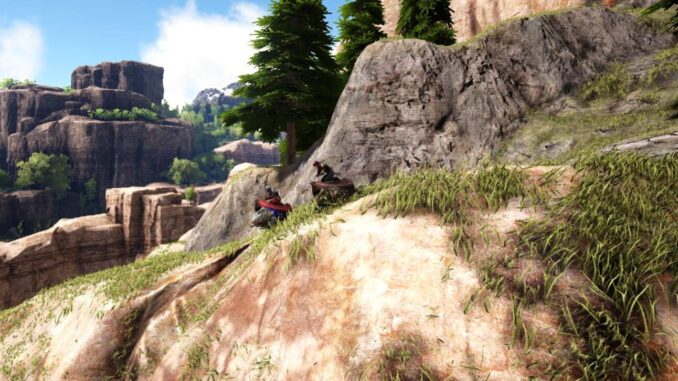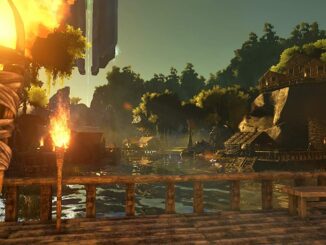
This guide describes how to properly use the Immersive Flight Reborn mod in detail. It goes over controls, visual and audio indicators, new mechanics and physics, and the general strategy of getting around with the mod.
The Basics
Note: Credit goes to Stilgar
Firstly, flyers can walk backward in this mod, and they no longer auto-fly when you get on them. Also take note of a couple of buffs that are on all IF flyers: Speed and Altitude. Altitude only really affects Quetzal, we’ll get to that in a minute, but especially watch your Speed. A flyer’s speed changes as it flies based on many factors, and this gauge will tell you how you’re doing. Before you take off both of these buffs will simply read ‘Landed’ as there’s not much to report, but once you take to the air they will read your speed in Meters/Second and your height above either the ground or water in Meters.
Now getting to the basics of actually flying, you’ll first notice that your flyer automatically moves forward without input. Unless it is a flyer with the ability to hover, it can no longer stop in mid-air, it has to keep flying, hence soaring being very useful. It also does not flap its wings automatically anymore, except to keep itself in the air at low speeds. You must tell your flyer that you want to accelerate by sprinting, at which point it will flap its wings . This costs more stamina than simply soaring above a certain speed, but it will cause the flyer to accelerate, which is why flapping up to the maximum speed and then soaring until you slow down a bit is the most efficient form of long-distance flight. You can also gain speed by aiming downward, and you lose speed by aiming upward or if you stop flapping. So:
- Left Shift (Run): Tells the flyer to flap its wings.
- S: Forces the flyer to dive without needing to aim down manually (your flyer will arc downward when you hold this button)
If you want your flyer to maintain its heading and keep soaring around at a set height, simply tap X. This toggles the flyer’s ‘Mouseflight’ mode, which is on by default. In Mouseflight, the flyer functions as normal and aims where you are pointing without any other input. When it’s off, the flyer aligns itself to the horizon and keeps going in whatever direction it was already heading. With Mouseflight off, you can use A and D to steer left and right, or hold W to make the flyer go where you’re looking again. This means:
- X: Toggle Mouseflight
- A/D: Steer in Mouseflight mode
- W: Enable Mouseflight while held
When it’s time to land, simply hold Spacebar and Shift together, and your flyer will begin braking. Below a certain speed, you can touch the ground and the flyer will land, but be careful not to brake too high up as it costs a lot of stamina for most flyers to hover like this, and you may run out of stamina before you reach the ground. Also, in the future landing at high speeds will deal damage, so try not to brake too late either.
Individual Flyers
Now that you know the basics of how to fly in general, we can take a look at how to handle each flyer individually, and what makes them special. For starters, the first flyer you’ll likely tame:
The Pteranodon
Top Speed: 28 m/s
Top Diving Speed: 35 m/s
Acceleration: Fast
Stamina Usage: High
This flyer accelerates very quickly and has the fastest base speed, but flapping uses quite a bit of stamina and it is not as aerodynamic as a feathered bird, so it is not well-suited for soaring great distances. But, if you plan out your trips with plenty of rest stops, you can easily cover them faster than a bird might.
New Ability: Side rolls
Double-tap A or D while in Mouseflight to perform a barrel roll to the side. These do no damage, but are useful for dodging obstacles or attacks.
The Argentavis
Top Speed: 24 m/s
Top Diving Speed: 38 m/s
Acceleration: Medium
Stamina Usage: Low
The Argentavis doesn’t accelerate quite as quickly as Pteranodon, or to the same high speed, but it is very aerodynamic and can maintain near-top speed with minimal effort. It will get you places a little slower, but it is perfectly suited for long-distance travel, and can stay in the air for the whole trip.
New Ability: Vulturesight
Hold Spacebar while looking at the ground and all creatures in a 30m-radius sphere will get indicators placed on them, visible to the rider. This ability has a very fast cooldown, and can be useful for spotting dinos hidden in foliage-dense areas.
The Pelagornis
Top Speed: 24 m/s
Top DIving Speed: 40 m/s
Acceleration: Medium
Stamina Usage: Very Low
This bird won’t be breaking any speed records, but with its massive wingspan and torpedo-like body it can easily soar for miles above the ocean. This mount is perfect for large island-hops, as even if it needs to stop for part of the trip it can land on the water.
New Ability: Diving
Diving through the air and hitting the water will allow the Pelagornis to dive underwater and swim around, eating fish. If it runs out of stamina or gets close to the surface, it will be placed back ontop and be able to take off again.
Tapejara
Top Speed: 24 m/s
Top Diving Speed: 33 m/s
Acceleration: Fast
Stamina Usage: Medium
It glides and soars with ease, and its massive wings give it a quick acceleration, but generate more drag and limit its maximum speed. It can still latch onto walls to regain stamina and below a certain speed it can still hover, but above that speed it functions like any other flyer. Useful for aerial ambushes.
Quetzalcoatlus
Top Speed: 12 m/s at 50m, 30 m/s at 300m
Top Diving Speed: 30 m/s
Acceleration: Slow
Stamina Usage: Medium
The Quetzal is the only flyer that really makes use of the altitude mechanics, where the higher up it goes the faster its base speed gets. Its speed is truly rather abyssmal below 50m, but at 300m it can outpace most other flyers.
Lymantria
Top Speed: 20 m/s
Top Diving Speed: 25 m/s
Acceleration: Medium
Stamina Usage: Medium
Lymantria is really not suited for long-distance or high-speed flight, instead being useful as a bomber as usual, and now as a farm hand! It makes up for its poor combat abilities with a few new helpful utility abilities.
New Ability: Silk Production
It now passively produces silk at a slow but useful rate. It stores a max of 100, and produces 2 every 5 minutes.
New Ability: Spore waterer
Its spore attack can be used to water crops without irrigation, allowing desert crops to thrive in spite of the low amount of water. Simply attack near the crops to water them.
New Ability: Hover
It gains the same hovering ability that Tapejara has.
Wyvern
Top Speed: 26 m/s
Top Diving Speed: 40 m/s
Acceleration: Slow
Stamina Usage: Medium on ground, High in air
Wyverns are very heavy, and as such have incredible dive speeds and can easily maintain their speed. However, this means they are awful at gaining altitude, and it takes quite a bit of force to accelerate. They have a trick up their sleeves to counter this though.
New Ability: Runway Take-off
Sprinting along the ground will cause the Wyvern to gain speed, which it will carry with it when it takes off. It is much cheaper to run than to flap, so this helps it fly more efficiently.
Other Things of Note
There are also a number of minor features that aren’t really important to flying itself, but will be handy to be aware of:
- The Wind sound and air particles appear above your Soaring Speed. If you see and hear them, then you know it’s possible to soar.
- The wingtip trails appear above your maximum base speed, showing that the flyer is diving.
- Flyers turn faster in Mouseflight mode than they do with A/D or diving.
- All flyers can swim, but only Pelagornis can take off again from water. Also Lymantria will drown in water.
- Stamina usage for both flapping and soaring is reduced dramatically when you’re going fast enough to soar.
- Wings have more forgiving collisions than the body, only slowing down the flyer instead of knocking it out of the air.





Be the first to comment